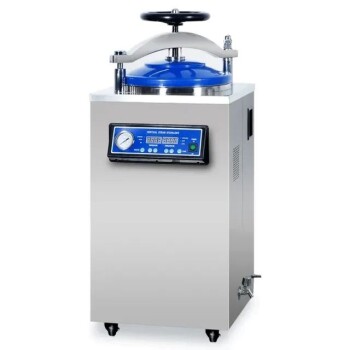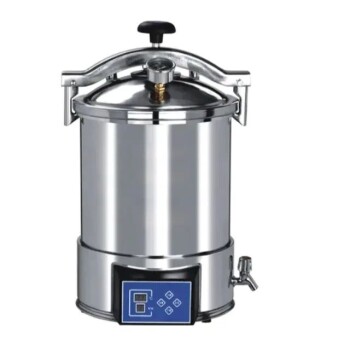
sterilization equipment
Laboratory Sterilizer Lab Autoclave Pulsating Vacuum Desktop Steam Sterilizer
Item Number : KT-B01
Price varies based on specs and customizations
- Fixed work stress
- 0.22Mpa
- Timing time selection range
- 0-99min
Shipping:
Contact us to get shipping details Enjoy On-time Dispatch Guarantee.
Why Choose Us
Reliable PartnerEasy ordering process, quality products, and dedicated support for your business success.
Introduction
This sterilizer is a safe, reliable and automatically controlled small-scale rapid desktop sterilization equipment, suitable for medical, pharmaceutical, scientific research and other units. It provides rapid sterilization for surgical, dental, ophthalmic instruments, glassware, medicines, culture media, fabric dressings, foods and other items that can withstand saturated steam.
Technical Parameters

| Model | KT-XB20J | KT-XB24J |
| Sterilization Chamber Volume | 20L | 24L |
| Sterilization Chamber Size | φ250×420mm | φ250×500mm |
| Rated Working Pressure | 0.22Mpa | 0.22Mpa |
| Rated Working Temperature | 134℃ | 134℃ |
| Sterilization Temperature Range | 105–134℃ | 105–134℃ |
| Timer Range | 0–60min | 0–60min |
| Temperature Uniformity in Chamber | ≤±1℃ | ≤±1℃ |
| Power Supply | 1.5KW / AC220V.50Hz (AC110V.60Hz) | 1.5KW / AC220V.50Hz (AC110V.60Hz) |
| Sterilization Tray (mm) | 340×200×30 (3 pieces) | 340×200×30 (3 pieces) |
| External Dimensions (mm) | 480×480×384 | 480×480×384 |
| Packing Dimensions (mm) | 700×580×500 | 700×580×500 |
| Gross/Net Weight | 44/40Kg | 50/45Kg |
Advantages
- At lease 3 or more times pulse-vacuum exhausting, which is applied to wrapped or unwrapped objects,hollow equipment.
- With inner printer, which record the for the full procedure of the sterilization.
- With Bowie&Dick testing function, which is for the steam penetrating testing.
- Self-testing malfunction, easy to maintain.
- Safety locking: the steam can not enter the chamber and the unit will alarm when the door is not closed tightly,and the door can not the open when the inner pressure is exceed 0.027mpa.
- Over pressure protection:If the pressure exceed the working pressure, the safety valve will exhausting the air.
- Low water protection:The unit can not be started if the water don’t reach the high level,and the power will cut off directly.
- Over current protection:The broker will cut off the power by the over current happened.
Designed for You
KinTek provide deep custom made service and equipment to worldwide customers, our specialized teamwork and rich experienced engineers are capable to undertake the custom tailoring hardware and software equipment requirements, and help our customer to build up the exclusive and personalized equipment and solution!
Would you please drop your ideas to us, our engineers are ready for you now!
FAQ
What Is Laboratory Vacuum Pump?
What Is A Steam Sterilizer?
What Are Some Common Applications Of Sterilization Autoclaves?
What Is The Purpose Of Vacuum Pump In Laboratory?
How Does A Steam Sterilizer Work?
How Long Does A Typical Sterilization Autoclave Cycle Take?
What Is The Use Of Pump In Laboratory?
What Are Some Common Applications Of Steam Sterilizers?
Can Autoclave Sterilization Be Validated For Effectiveness?
What Is Used In A Laboratory To Form And Contain A Vacuum?
How Long Does A Typical Steam Sterilizer Cycle Take?
Can Autoclave Sterilization Damage Certain Materials?
How Does A Laboratory Vacuum Pump Work?
Can Steam Sterilization Be Validated For Effectiveness?
How Should Autoclave Sterilization Be Monitored And Documented?
Can Steam Sterilization Damage Certain Materials?
4.9
out of
5
I'm impressed with the fast delivery of this steam sterilizer. It arrived within 3 days of placing the order.
4.7
out of
5
Excellent value for the price! This sterilizer is a great addition to my lab, and it works perfectly.
4.8
out of
5
The quality of this sterilizer is top-notch. It's made of durable materials and built to last.
4.9
out of
5
I've been using this sterilizer for a few months now, and it has never failed me. It's reliable and consistent.
4.7
out of
5
The technological advancement in this sterilizer is impressive. It's easy to use and has many features that make sterilization efficient.
4.8
out of
5
I highly recommend this sterilizer to anyone in the medical field. It's a valuable piece of equipment that ensures the safety of patients and staff.
4.9
out of
5
The sterilizer's ability to effectively remove air and achieve sterilization in a short amount of time is remarkable.
4.7
out of
5
The safety features of this sterilizer give me peace of mind. It's equipped with multiple protection mechanisms to prevent accidents.
4.8
out of
5
The sterilization process is well-monitored with mechanical, chemical, and biological indicators, ensuring the effectiveness of sterilization.
4.9
out of
5
The ability to sterilize a wide range of items, including surgical instruments, dental tools, and glassware, makes this sterilizer versatile and suitable for various applications.
4.7
out of
5
The compact size of the tabletop sterilizer makes it ideal for small spaces and portable use in clinics and laboratories.
4.8
out of
5
The built-in printer is a great feature that allows for easy documentation and record-keeping of sterilization cycles.
4.9
out of
5
The customer service provided by KINTEK SOLUTION was exceptional. They were responsive and helpful in answering all my queries.
REQUEST A QUOTE
Our professional team will reply to you within one business day. Please feel free to contact us!
Related Products

Desktop Fast Laboratory Autoclave Sterilizer 20L 24L for Lab Use
The desktop fast steam sterilizer is a compact and reliable device used for rapid sterilization of medical, pharmaceutical, and research items.

Laboratory Sterilizer Lab Autoclave Pulse Vacuum Lifting Sterilizer
The pulse vacuum lifting sterilizer is a state-of-the-art equipment for efficient and precise sterilization. It uses pulsating vacuum technology, customizable cycles, and a user-friendly design for easy operation and safety.

Portable High Pressure Laboratory Autoclave Steam Sterilizer for Lab Use
Portable autoclave sterilization pressure is a device that uses pressure saturated steam to quickly and effectively sterilize items.

Desktop Fast Laboratory Autoclave Sterilizer 35L 50L 90L for Lab Use
The desktop fast steam sterilizer is a compact and reliable device used for rapid sterilization of medical, pharmaceutical, and research items. It efficiently sterilizes surgical instruments, glassware, medicines, and resistant materials, making it suitable for various applications.

Laboratory High Pressure Horizontal Autoclave Steam Sterilizer for Lab Use
The horizontal autoclave steam sterilizer adopts the gravity displacement method to remove the cold air in the inner chamber, so that the inner steam and cold air content is less, and the sterilization is more reliable.

Laboratory High Pressure Steam Sterilizer Vertical Autoclave for Lab Department
Vertical pressure steam sterilizer is a kind of sterilization equipment with automatic control, which is composed of heating system, microcomputer control system and overheating and overpressure protection system.

Desktop Fast High Pressure Laboratory Autoclave Sterilizer 16L 24L for Lab Use
The desktop fast steam sterilizer is a compact and reliable device used for rapid sterilization of medical, pharmaceutical, and research items.

Laboratory Horizontal Autoclave Steam Sterilizer Lab Microcomputer Sterilizer
The horizontal autoclave steam sterilizer adopts the method of gravity displacement to remove the cold air in the inner chamber, so that the content of steam cold air in the inner chamber is less, and the sterilization is more reliable.

Liquid crystal display automatic vertical sterilizer is a safe, reliable and automatic control sterilization equipment, which is composed of heating system, microcomputer control system and overheating and overvoltage protection system.

Portable Digital Display Automatic Laboratory Sterilizer Lab Autoclave for Sterilization Pressure
Portable autoclave sterilization pressure is a device that uses pressure saturated steam to quickly and effectively sterilize items.

Laboratory Sterilizer Lab Autoclave Herbal Powder Sterilization Machine for Plant
The herbal powder sterilization autoclave machine for Chinese medicine uses saturated steam for effective sterilization. It utilizes the heat and penetrative properties of steam, achieves sterilization after heat preservation, and maintains a good drying effect with a dedicated drying system.

Stainless High Pressure Autoclave Reactor Laboratory Pressure Reactor
Discover the versatility of Stainless High Pressure Reactor - a safe and reliable solution for direct and indirect heating. Built with stainless steel, it can withstand high temperatures and pressures. Learn more now.

Mini SS High Pressure Autoclave Reactor for Laboratory Use
Mini SS High Pressure Reactor - Ideal for medicine, chemical, and scientific research industries. Programmed heating temp and stirring speed, up to 22Mpa pressure.

Customizable High Pressure Reactors for Advanced Scientific and Industrial Applications
This laboratory-scale high-pressure reactor is a high-performance autoclave engineered for precision and safety in demanding research and development environments.

Laboratory Benchtop Water Circulating Vacuum Pump for Lab Use
Need a water circulating vacuum pump for your lab or small-scale industry? Our Benchtop Water Circulating Vacuum Pump is perfect for evaporation, distillation, crystallization, and more.

Laboratory Vertical Water Circulating Vacuum Pump for Lab Use
Looking for a reliable water circulating vacuum pump for your lab or small-scale industry? Check out our Vertical Water Circulating Vacuum Pump with five taps and a larger air sucking amount, perfect for evaporation, distillation, and more.

High Pressure Laboratory Autoclave Reactor for Hydrothermal Synthesis
Discover the applications of Hydrothermal Synthesis Reactor - a small, corrosion-resistant reactor for chemical labs. Achieve rapid digestion of insoluble substances in a safe and reliable way. Learn more now.

High Pressure Laboratory Vacuum Tube Furnace Quartz Tubular Furnace
KT-PTF High Pressure Tube Furnace: Compact split tube furnace with strong positive pressure resistance. Working temp up to 1100°C and pressure up to 15Mpa. Also works under controller atmosphere or high vacuum.
Related Articles

The Thermodynamics of a Perfect Seal: A Component-Level Approach to Sterilization
Learn why autoclaving your entire electrolytic cell destroys the seal. A guide to understanding material properties and protecting your experiments.

Affordable Rotavapor How to Save on Your Purchase
Rotavapor is a laboratory equipment that is used for distillation, purification, and concentration of liquid samples. It is a vital tool for chemists, biologists, and other researchers who work with various types of solvents and chemicals.

Installation of Tube Furnace Fitting Tee
Mainly introduces the installation method of tube furnace fitting tee.

Basic Cleaning and Disinfection Equipment in the Laboratory
Overview of essential lab cleaning and disinfection tools and their operational principles.

Basic Laboratory Drying Equipment
Overview of various drying equipment used in laboratories, including vacuum, blast, electric heating, hot air disinfection, and infrared drying ovens.

Hazards and Safety Precautions of Laboratory Pressure Vessels
An overview of the dangers and safety measures for pressure vessels in laboratory settings.

Laboratory Safety: High Pressure Equipment and Reactors
This article discusses safety measures and precautions for using high pressure equipment and reactors in laboratories, including case studies and detailed usage instructions.

Water Circulating Vacuum Pumps: A Practical Guide for Laboratory Applications
Discover the benefits of water circulating vacuum pumps for labs: chemical safety, low maintenance, and explosion-proof operation. Ideal for sensitive applications.

Operating Procedures for Vacuum Sintering Furnace
Detailed steps and precautions for operating a vacuum sintering furnace.

Basic Laboratory Purification Equipment Overview
An overview of essential purification equipment used in laboratories, including water purification, solvent evaporation, and waste treatment systems.

Application of Low-Temperature Pulverization Technology in the Spice Industry
Explores the benefits of low-temperature pulverization for maintaining spice quality and efficiency.

Preparation Technologies and Applications of High-Purity Metals
An in-depth look at the definition, preparation technologies, and applications of high-purity metals.